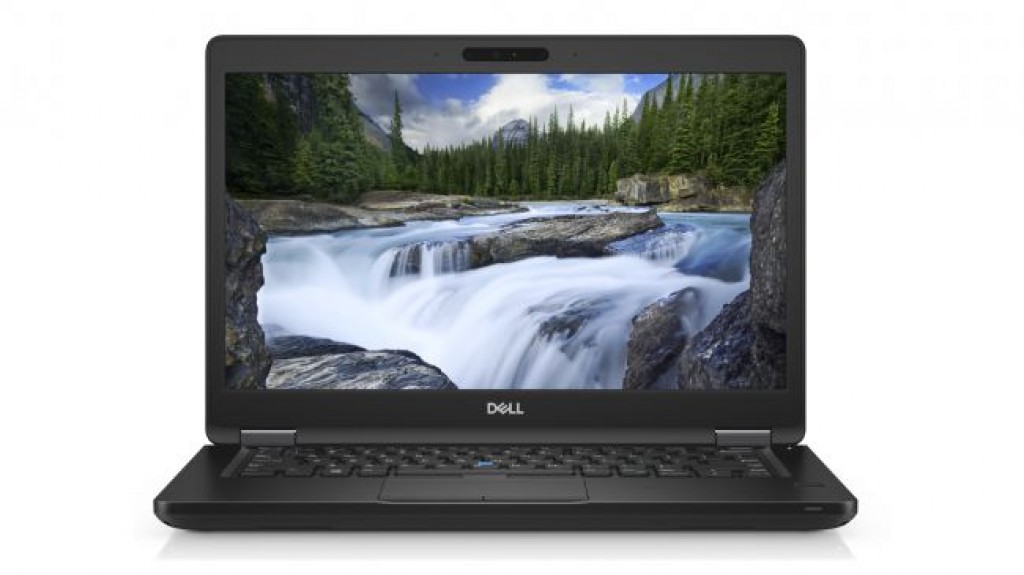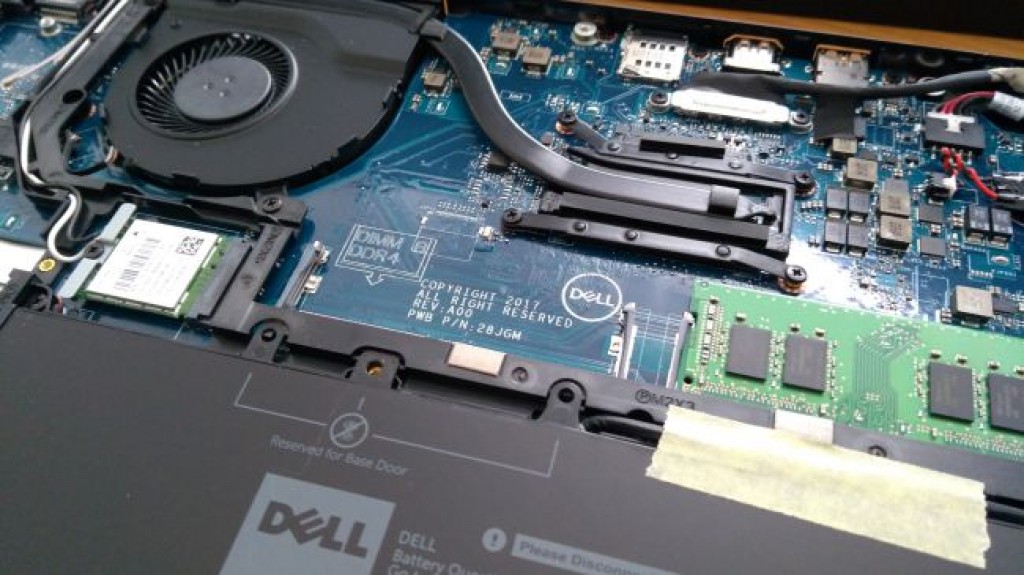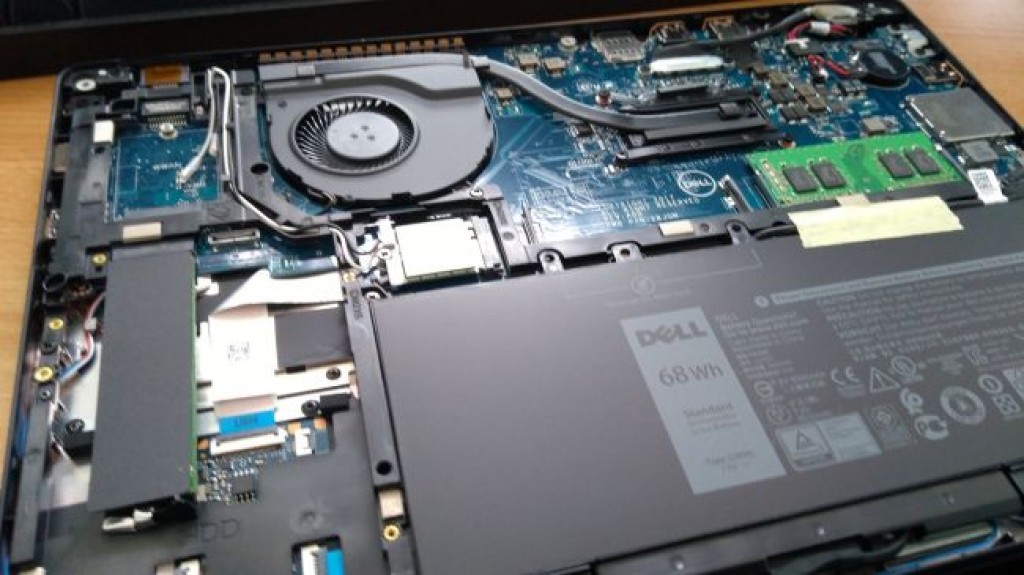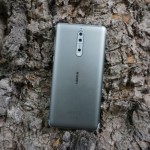
OUR VERDICT
This laptop is an accomplished all-rounder that delivers all the features that business users want at an affordable price. Sadly, there isn’t enough free drive space on this model, but Dell sells plenty of other versions that address this issue.
FOR
- Competitively priced
- Punchy processor
- Excellent feature set
AGAINST
- 128GB SATA SSD
- Proprietary charger
- Mostly plastic
The Dell Latitude series has always been popular with business buyers. As they deliver precisely the feature sets that corporate IT wants at a price the finance department can stomach.
The lowest rung on the Latitude ladder is the 3000 series machines with 11” screens that use a Celeron CPU. At the opposite end of that scale are the high-end Core i7 7000 series systems with all manner of sophisticated features. And between those are 2-in-1 designs, ruggedised models, and what we’re investigating today; the 5000 series.
The Dell Latitude 5490 is the latest 5000 series design to be added and aims to keep Dell well represented when the debate turns to new productivity tools at the next board meeting.

Price, availability and value
For those unfamiliar with the Dell approach to selling computers, a basic selection of sub-models for any design and you can customise them to varying degrees from there.
The Latitude 5490 comes in eleven different configurations that start at £709 (around $965) ex VAT and go up to £1,109 (around $1,500) depending on processor, memory, display and storage options.
You can also make them cost more by adding options like a SmartCard reader, LTE modem and fingerprint scanner, or including accessories like the Dell Business Dock. The Latitude 5490 reviewed here replaces the 5480, a very well respected design, and a strong competitor in a sector with impressive offerings from Acer, HP, Lenovo and Toshiba amongst others.
One critical difference between the Dell US and Europe product options is that the reviewed design isn’t one available in the American range.
The $799 (around £586) version of the Latitude 5490 stateside has only 4GB of RAM, a 500GB DATA drive and a lower resolution 1366 x 768 display. The inclusion of 1080p screen is exclusive to those systems that come with the Core i7-8650U or i5-8350U processors.

Design
Because this machine isn’t a Dell XPS, we expected plastic over a metal interior, and our assumptions weren’t contradicted.
Irrespective of the materials, the Latitude 5490 feels well made, substantial and the surface texture makes it easy to handle. That last point is important, as it weighs 1.6Kg and dropping it might have unpleasant consequences.
That’s a little on the heavy side for this type of machine, but there is plenty of computer inside the black exterior to compensate for carrying it.
The first thing we noticed about it was that the external ports are almost evenly distributed between left, right and the rear. With a full size Type A USB port on each side. As a rule, it’s normally considered a poor plan to put ports on the hinge spine, as that’s where the greatest angular breaking force is often applied should the machine fall or tip over.
Dell acknowledged this to a degree in the placement of the power port and the LAN socket. They’re mounted in each of the hinge plates, providing them with a metal surround that offers some protection from a calamity to these ports.
How much protection that offers is difficult to predict, but anything is better than a broken notebook that you can’t power, charge or can only network using WiFi.
The keyboard on the 5490 was a very pleasant surprise, as has a decent spacing between the keys and a very positive if slightly bouncy action. It is also backlit, should you need to work in low light conditions, like those in a projected presentation.

Our only dislike with the keyboard is how small Dell decided to make the cursor keys, which are tiny considering how often a typical user will need to use them. At the centre of the keyboard is a ‘nipple’ for those who loved their ThinkPad once, though the touchpad is a much better option for controlling the cursor for most users.
Dell touchpads have improved markedly, and the one on the 5490 is large, has buttons at both the top and the bottom, and supports single, double, triple or four finger gestures.
Most users will probably stop at pinching and scrolling, but those that learn these gestures can invoke Cortana or the action centre with a single movement. A weakness of machine built to a very exactly price is often the screen, but the one used in the review model looked perfectly serviceable to us.
With a 1080p resolution and a brightness of 200 nits, it works well for typical office use, and at this resolution, the interface doesn’t require any extreme interface scaling.
We’ve seen brighter and more colourful displays on other brands, most noticeably from Fujitsu, but the screen on this PC will be acceptable for most users.
It isn’t a touch-capable display, and Dell doesn’t offer touch on any Latitude 5490 currently.
As this system isn’t a 2-in-1, its omission isn’t a huge loss, unless you are addicted to putting smudgy fingerprints on the screen. So far, everything about the Latitude 5490 is good, or good enough.
Specifications
The specification of this machine swings rather wildly from making perfect sense to almost none at all.
On the logical side of that line is the Intel Core i5-8250U CPU, an excellent Kaby Lake-U series chip that can trundle along at 1.6GHz until the hard work kicks it up to 3.38 GHz in turbo mode. It manages this with a maximum TDP of just 15 watts, and the four cores can each handle deal tasks per core for a maximum of eight threads.
That chip combined with the 8GB of DDR4 memory make for a smooth experience, and there are enough external ports for most users.
It irks us that Dell is still placating people who use VGA screens, but for those living in the 21st century they can connect via HDMI or use DisplayPort over the USB Type C port.
The highest specification models have this port upgraded to Thunderbolt 3, but not on the reviewed hardware spec. But where the specifications go entirely awry is in the storage department, where Dell confusingly used an M.2 drive that offers no practical advantage over a SATA connected SSD.
The logic appears to be that because the 128GB module in the review model is M.2, then it is worth more than the 2.5-inch 500GB hard drive on other models. Well, it will be quicker, but with such little space left (88GB on the review machine), it kneecaps what is otherwise a very useful piece of equipment.
What made even less sense was why M.2 technology was used for the drive. Because the machine obviously has the space for a 2.5-inch mechanism, as in the hard drive models, therefore why not use a bigger SATA SSD? The argument about M.2 offering ultimate performance doesn’t hold any water either, as Dell chose only to use only SATA M.2 modules over the entire range in the UK and not NVMe.

There aren’t any easy user upgradable options either, so unless you fancy dismantling the Latitude, you can’t utilise that empty 2.5-inch drive bay ever. For those who don’t mind removing screws and cloning drives disappointment awaits.
The M.2 slot and the 2.5-inch SATA bay occupy the same physical space, so you can’t have both. And, the M.2 version of the machine is also missing the cables and shroud to mount the 2.5-inch drive.

Based on that revelation, we suspect that those models provided with 2.5-inch drives are missing the corresponding elements to use the M.2 slot.
However, there is a little light at the end of this tunnel. In the manual it mentions that the M.2 slot can take both SATA and NVMe drives, allowing you to buy the 128GB review version and then upgrade it to an NVMe drive of whatever size you can afford (up to 1TB).
The only caveat to this exercise is that the drives will need to be cloned outside the machine, ideally using a desktop PC with two spare M.2 slots. Or, make a recovery drive, and do a total rebuild at the outset.
Opening up the 5490 also allows the memory to be upgraded to 32GB filling both memory slots provided, having first removed the single pre-installed 8GB module. Another oddity is that the machine has a SIM card slot, for those wishing to have network connections over mobile phone technology. But inserting a SIM won’t provide this, as you must buy and install an additional WWAN module to enable this functionality.
Dell went to the trouble of mounting the tray and the antenna by default in every 5490 but frustratingly left out the WWAN module. The battery spec of this machine can vary from a 42 to 51 or 68 Whr, and the review hardware had the biggest of those for the longest operating battery life.
Performance
Unless you are used to a gaming laptop, the Dell Latitude 5490 will seem very responsive across a wide range of applications. This design showcases the Intel 8th-generation processors well, being both strong in a single task scenario and also impressive when the problem is multi-threaded.
The only caveat to this is that the system automatically gears the CPU and memory down when running on battery, where you can often find that the machine is only half as powerful as it is on mains power.

There are two common themes to the benchmark results; decent processing power and drive speeds. However, the drive performance could have been so much better, had Dell offered NVMe. Or, used 2.5-inch SATA SSDs, models might have had 4TB of storage in them.
That large, and heavy, battery does at least offer some operational longevity if mains power isn’t handy. With PCMark08 Work test projecting a continuous operating time of 7 hours and 14minutes.
That’s more than respectable and should get the majority of users through a standard working day.
Dell should be pleased that its Kaby Lake U class machine is a little quicker than most that we’ve tested so far, but only marginally.
What might have boosted some of these numbers is NVMe storage, although that might have elevated the cost by at least £200 ($230).
Having an Intel 620 GPU doesn’t propel the graphics performance to gaming level, but it can play back HD video very nicely and is sufficient for presentation work.
Final verdict
The Dell Latitude 5490 is a rather odd combination of solid design with some head-scratching storage choices. The level of power and battery life should make it a pleasant experience for most users, presuming that those ordering the machine chose a model with sufficient drive space to use it in anger.
Source: techradar.com









































